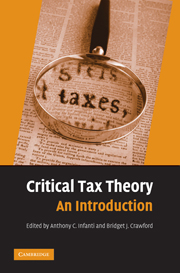Book contents
- Frontmatter
- Contents
- List of Illustrations
- List of Tables
- List of Contributors
- List of Common Abbreviations
- Introduction
- CHAPTER 1 FOUNDATIONS OF CRITICAL TAX THEORY
- CHAPTER 2 HISTORICAL PERSPECTIVES ON TAXATION
- CHAPTER 3 THE GOALS OF TAX POLICY
- CHAPTER 4 CRITICAL TAX THEORY MEETS PRACTICE
- CHAPTER 5 RACE AND TAXATION
- CHAPTER 6 GENDER AND TAXATION
- CHAPTER 7 SEXUAL ORIENTATION AND TAXATION
- CHAPTER 8 THE FAMILY AND TAXATION
- CHAPTER 9 CLASS AND TAXATION
- Women, Poverty, and the Tax Code: A Tale of Theory and Practice
- The Working Poor Are Paying for Government Benefits: Fixing the Hole in the Anti-Poverty Purse
- Welfare by Any Other Name: Tax Transfers and the EITC
- Race, Class, and the Internal Revenue Code: A Class-Based Analysis of A Black Critique of the Internal Revenue Code
- CHAPTER 10 DISABILITY AND TAXATION
- CHAPTER 11 GLOBAL CRITICAL PERSPECTIVES ON TAXATION
- CHAPTER 12 CRITICAL PERSPECTIVES ON CRITICAL TAX THEORY
- Index
Race, Class, and the Internal Revenue Code: A Class-Based Analysis of A Black Critique of the Internal Revenue Code
Published online by Cambridge University Press: 04 August 2010
- Frontmatter
- Contents
- List of Illustrations
- List of Tables
- List of Contributors
- List of Common Abbreviations
- Introduction
- CHAPTER 1 FOUNDATIONS OF CRITICAL TAX THEORY
- CHAPTER 2 HISTORICAL PERSPECTIVES ON TAXATION
- CHAPTER 3 THE GOALS OF TAX POLICY
- CHAPTER 4 CRITICAL TAX THEORY MEETS PRACTICE
- CHAPTER 5 RACE AND TAXATION
- CHAPTER 6 GENDER AND TAXATION
- CHAPTER 7 SEXUAL ORIENTATION AND TAXATION
- CHAPTER 8 THE FAMILY AND TAXATION
- CHAPTER 9 CLASS AND TAXATION
- Women, Poverty, and the Tax Code: A Tale of Theory and Practice
- The Working Poor Are Paying for Government Benefits: Fixing the Hole in the Anti-Poverty Purse
- Welfare by Any Other Name: Tax Transfers and the EITC
- Race, Class, and the Internal Revenue Code: A Class-Based Analysis of A Black Critique of the Internal Revenue Code
- CHAPTER 10 DISABILITY AND TAXATION
- CHAPTER 11 GLOBAL CRITICAL PERSPECTIVES ON TAXATION
- CHAPTER 12 CRITICAL PERSPECTIVES ON CRITICAL TAX THEORY
- Index
Summary
Economic class differences within the black community should be considered, in conjunction with the history of black racial oppression, in developing proposals to reduce economic disparities between whites and blacks. In A Black Critique, Professors Beverly Moran and William Whitford documented the white and black tax gap by analyzing the extent to which blacks and whites benefit from certain provisions of the Code. They focused primarily on Code sections related to wealth while controlling for factors such as race, “income, education, region and marital status.” They concluded that race was a statistically significant predictor of the benefit that whites and blacks receive from the Code, with whites benefiting disproportionately.
Professors Moran and Whitford did not analyze class differences within the black community; they focused on the tax provisions' impact upon blacks in the aggregate in developing strategies to remedy the tax gap. Their proposals, however, reflect a bias toward lower-income blacks and against the economic interests of middle-income blacks due to their focus on race as the primary determinant of the tax disparities. That analysis leads to overly broad prescriptions. The racial tax disparity is a consequence of the historical effects of racial subordination, reflected in wealth disparities between whites and blacks. As a result, a race-based approach will not adequately address the problem because it may eliminate tax provisions that benefit middle-income blacks in an effort to assist lower-income blacks who are unable, due to their economic condition, to utilize those provisions.
- Type
- Chapter
- Information
- Critical Tax TheoryAn Introduction, pp. 290 - 298Publisher: Cambridge University PressPrint publication year: 2009



